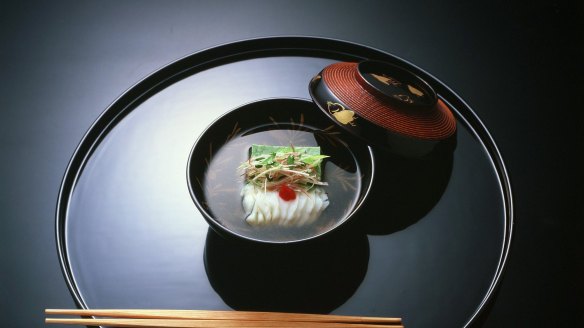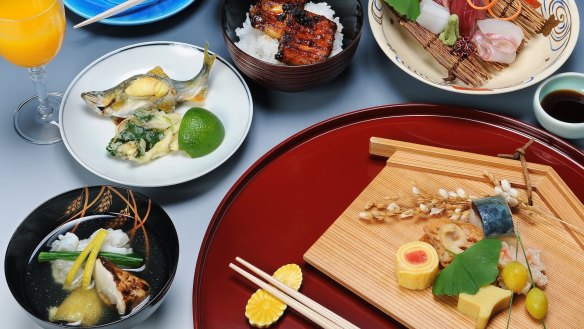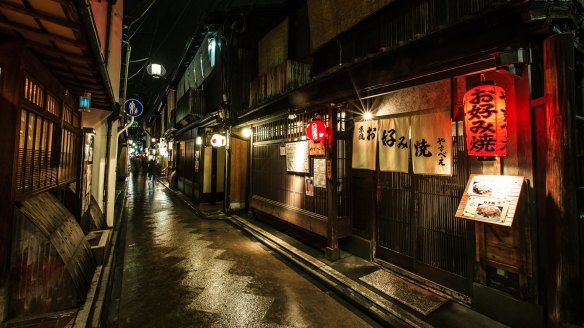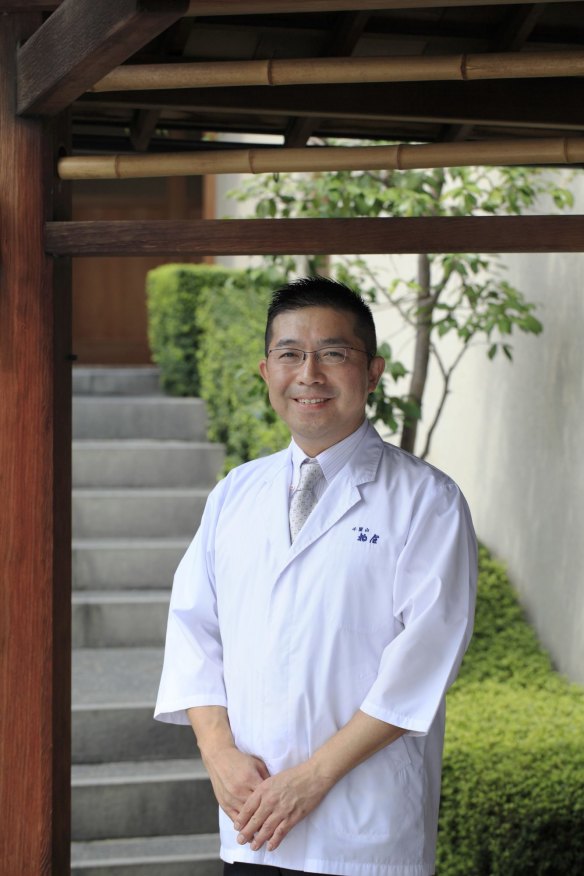In search of kaiseki, Japan's performance art with flavour

You might well feel like a clumsy oaf as you follow your kimono-clad hostess across stepping stones in a gravel courtyard. She will fold herself into a kneeling position on a tatami mat, a human origami of shimmering silk and studied grace. She'll pour sake with the gentle gurgle of a mountain stream, and murmur Japanese phrases, and serve delicious but bemusing dishes whose ingredients you might only guess at: tofu delicate as custard, strangely bitter fish, weird sea creatures, purple flowers.
The chef emerges and there'll be smiling and bowing, and when your meal is done you're told what an honour it is that you've dined in such a humble establishment. You'll totter off slightly mystified but feeling something extraordinary has happened. You've eaten an artwork, the food of angels, and been allowed to glimpse a lovely world of elegant ritual.
A kaiseki meal is the ultimate form of Japanese dining: haute cuisine meets high theatre. Don't be intimidated, because it's one of Japan's great cultural experiences. Besides, most Japanese don't even understand it, and many big-city kaiseki restaurants are used to foreign diners. Hostesses might well speak some English. They graciously advise you on the protocol of sashimi-eating (oily fish last, so as not to stain the soy sauce) or what that leaf might be (shobu, whose shape recalls a samurai sword).

Kaiseki is an ornate, prettily presented, multicourse meal that emphasises quality seasonal ingredients. Menus can change by the day, depending on what the chef buys or forages. Dishes are deceptively simple and favour light, natural flavours, though Tokyo kaiseki tends to stronger sauces. Fortunately, kaiseki is served as a set menu, so you won't need to grapple with ordering, nor need to know that hassun is the name for the early appetiser course based on seasonality, or that the mukozuke (sashimi) course is always accompanied by sake. Dishes arrive in graceful succession.
Derived from the imperial and samurai cuisines of Kyoto, Japan's former capital, kaiseki incorporates elements of less elaborate temple and tea-ceremony cuisines. These days, innovative chefs experiment with ingredients and cooking techniques from beyond Japan. At Kashiwaya in Osaka, for example, French-influenced chef Hideaki Matsuo serves crabmeat souffle and petits fours with green tea among more traditional courses such as tofu and eggplant with sea cucumber, or octopus with pickled plums.
Energetic trading city Osaka is wealthy, progressive and competitive, and as a result has an excellent and innovative kaiseki scene. At Asai Togei you'll find flavours sneak in from Okinawa, where its chef Kousei Togei was born, and even Europe: pickled mackerel might come with basil sauce, and your dessert could well be cheesecake.

Kaiseki is more than mere ingredients, however. You might say it's a philosophy. Hospitality is key, so the meal is never rushed – count on three hours – and usually served in a private tatami room decorated with calligraphy and artfully arranged twigs or flowers. A top kaiseki restaurant often overlooks a Japanese garden or distant hills, since nature is admired. Tableware comes in the form of fish or leaves, dishes are arranged to evoke ponds or mountains.
Cultural references might well be lost, but never mind. Just know that kaiseki meals have a meditative quality. Ponder the prettiness of your fish dish, admire the irises gracing a vase, study the bowl in which your soup is served, and you're on your way to kaiseki insight.
What you can more obviously appreciate, as your courses progress, is the way kaiseki balances various tastes, textures and aromas, and showcases cooking techniques such as steaming, boiling, frying and grilling. Tableware and serving dishes are carefully selected and often unique to the restaurant. Utterly beautiful plating balances appearance and colour, with garnishes chosen to represent the season.

Kaiseki chefs strive for excellence, if not perfection. A cardinal sin would be to arrive later than your booking, since preparation is carefully timed. Nihonryori RyuGin, one of Tokyo's best kaiseki restaurants, even frowns on guests taking photos of dishes, since the "value and essence of the food fades by the second" and should be enjoyed at its best, immediately upon being served. Chef Seiji Yamamoto ought to know what he's talking about: he has three Michelin stars for his light, contemporary kaiseki, often influenced by molecular gastronomy techniques.
Another great Tokyo option is Kagurazaka Ishikawa, where chef Hideki Ishikawa also has three Michelin stars, maintained since the first Tokyo edition of the gastronomic guide in 2007. You dine amid blond wood and bamboo, lulled by the tinkling of water in a koi pond, as you meander through some of the world's most beautifully presented and flavoursome dishes: lemongrass-infused horsehair crab; clam soup like the very essence of ocean; lobster delicate with miso and ginger, grilled to perfection.
Kaiseki's heartland, though, is Kyoto, from which it originated. No surprise that the city that strives to preserve its cultural traditions has rather obsessive kaiseki chefs. At Gion Nishikawa, chef Masayoshi Nishikawa has to source his eels from Nushima, his abalone from Nagasaki and his water from a particular Kyoto well, which he considers adds just the right flavour to his kelp. Needless to say, his mukozuke course of sashimi is simply superb.
If you want to see where some kaiseki ingredients come from, head along to the 400-year-old Nishikikoji-dori (Nishiki Market Street), whose tiny stalls and shops specialise in traditional local foods such as tofu, Kamo eggplants, quail eggs and knobbly wasabi freshly grated on shark-skin graters. You could cobble together a kaiseki picnic here.
At the other end of the spectrum, though, Kyoto Kitcho provides arguably the world's best kaiseki meal – though in a restaurant infamous as one of the world's most expensive. Count on more than $600 a head for chef Kunio Tokuoka's multicourse extravaganza, served on 400-year-old ceramics.
Ishibe-kouji Kamikura is another outstanding Kyoto kaiseki restaurant under the helm of chef Yoshiko Yano. It hosts just eight people, but three chefs work to produce the nine-course meal, which might include a ground-lotus dumpling stuffed with seafood and marooned in an edible-flower soup, or charcoal wagyu beef that dissolves like marshmallow and is pocked with taste explosions of bitter orange and wasabi.
It's a feast for the eyes, the palate and the mind, conjured up through decades of experience and centuries of tradition. In a theatre, you'd leap up and applaud. In a kaiseki restaurant, you just shuffle away into the night, trying to look graceful, yet secretly bedazzled by this performance art with flavour.
DETAILS
Kashiwaya, jp-kashiwaya.com
Asai Togei, asaitogei.com
Nihonryori RyuGin, nihonryori-ryugin.com
Kagurazaka Ishikawa, kagurazaka-ishikawa.co.jp
Gion Nishikawa, r.goope.jp/gion-nishikawa
Nishikikoji-dori (Nishiki Market Street)
Kyoto Kitcho, kyoto-kitcho.com
Ishibe-kouji Kamikura, kyoto-kamikura.com
Brian Johnston was a guest of the Japan National Tourism Organisation and Kyoto Convention & Visitors Bureau.
Restaurant reviews, news and the hottest openings served to your inbox.
Sign up